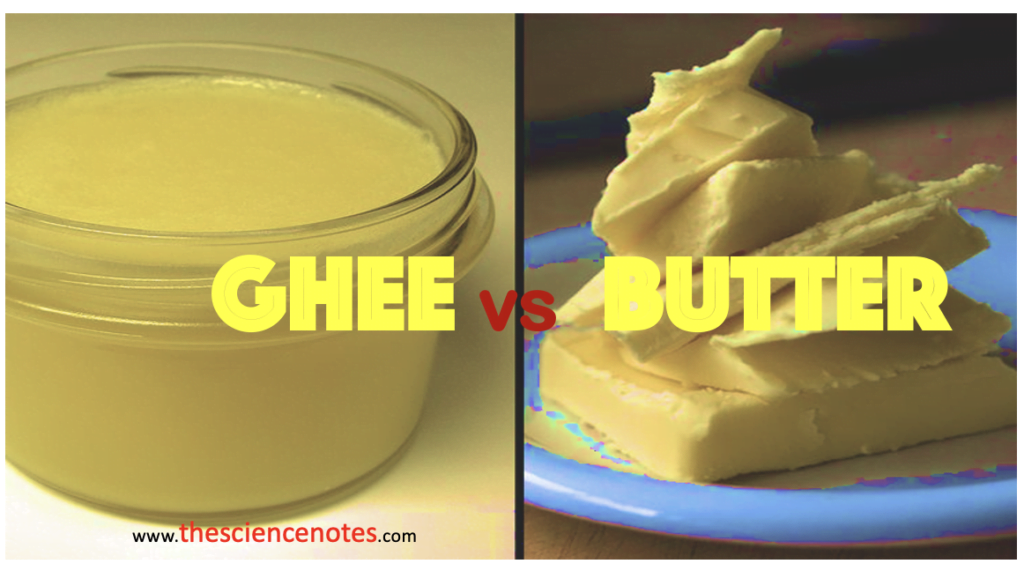What is Butter?
Butter is a dairy product, produced by churning cream or milk. It originates mainly from cow’s milk, but can be made from other animal milks like goats, buffalo, or sheep. Through churning, the cream’s fat globules combine, resulting in the separation of butterfat and buttermilk. The collected butterfat solidifies to form butter. Butter and Ghee will be compared in this article.
Butter boasts a rich, creamy texture and a distinct buttery flavor. It serves as a versatile ingredient in cooking, baking, and spreading on bread or toast. Its addition enhances dishes by imparting moisture, richness, and flavor. Comprising around 80% milk fat, butter also contains water and milk solids, responsible for its yellow color and taste.
Apart from its culinary significance, butter provides fat-soluble vitamins such as A, D, E, and K. It also contains traces of water-soluble vitamins and minerals. Nevertheless, it’s crucial to consume butter in moderation as part of a balanced diet due to its high saturated fat content.
| Characteristic | Description |
| Texture | Creamy |
| Flavor | Rich and buttery |
| Color | Yellow |
| Composition | |
| Fat | Approximately 80% milk fat |
| Water | Approximately 15-17% water content |
| Milk Solids | Approximately 2-3% milk solids, including proteins and minerals |
| Nutritional Value | |
| Saturated Fat | High |
| Vitamins | Contains small amounts of fat-soluble vitamins (A, D, E, K) |
| Minerals | Contains small amounts of water-soluble minerals |
| Shelf Life | Longer shelf life compared to regular butter |
| Refrigeration | Does not require refrigeration |

What is Ghee?
Ghee, a clarified butter used in traditional cooking for centuries, is created by simmering butter. This process evaporates water and separates and removes milk solids, resulting in ghee, a golden liquid.
With its rich, nutty flavor and higher smoke point compared to regular butter, ghee excels in high-heat cooking methods like frying and sautéing. Its extended shelf life eliminates the need for refrigeration.
Not only is ghee renowned for its culinary applications, but it also holds value in Ayurvedic medicine. Believed to enhance digestion, support brain function, and nourish the body, ghee offers potential health benefits.
In summary, ghee stands as a versatile and flavorful ingredient, imparting a distinctive taste to various dishes while potentially providing health advantages.
| Characteristic | Description |
| Texture | Smooth and creamy |
| Flavor | Rich, nutty |
| Color | Golden |
| Composition | |
| Fat | 100% milk fat |
| Water | Virtually water-free |
| Milk Solids | Virtually lactose and casein-free |
| Nutritional Value | |
| Saturated Fat | High |
| Vitamins | Contains small amounts of fat-soluble vitamins (A, D, E, K) |
| Minerals | Contains small amounts of water-soluble minerals |
| Shelf Life | Longer shelf life compared to butter |
| Refrigeration | Does not require refrigeration |
| Smoke Point | Higher smoke point compared to regular butter, ideal for high-heat cooking methods |
Differences between Butter and Ghee
| Features | Butter | Ghee |
| 1.Composition | Contains milk fat, water, and milk solids | Consists of pure milk fat; water and milk solids are removed |
| 2. Production | Made by churning cream or milk | Prepared by simmering butter to separate fat from milk solids and water |
| 3. Shelf Life | Relatively short shelf life, typically a few weeks in the refrigerator | Longer shelf life, can be stored at room temperature for several months |
| 4. Smoke Point | Low smoke point (around 350°F or 175°C) | High smoke point (around 450°F or 232°C), making it suitable for high-temperature cooking |
| 5. Flavor | Mild, creamy taste | Rich, nutty flavor |
| 6.Clarification | Not clarified; retains milk solids | Clarified by removing milk solids, resulting in a pure fat |
| 7. Lactose Content | Contains trace amounts of lactose | Virtually lactose-free, as the milk solids are removed |
| 8.Allergenicity | May trigger dairy allergies in sensitive individuals | Less allergenic due to the removal of milk solids |
| 9. Nutritional Profile | Contains vitamins A, D, E, and K, along with trace minerals | Retains some fat-soluble vitamins but loses some water-soluble vitamins during clarification |
| 10. Culinary Uses | Versatile for baking, sautéing, and spreading | Ideal for high-heat cooking, deep frying, and traditional Indian cooking |
Similarities between Butter and Ghee
| Features | Butter | Ghee |
| 1. Composition | Both are derived from milk and contain milk fat | Both are derived from milk and consist mainly of milk fat |
| 2. Production | Both are produced by processing milk or cream | Both are produced by churning or simmering milk or cream |
| 3. Taste | Both have a distinct flavor | Both have a unique taste profile |
| 4. Culinary Uses | Both are used for cooking, baking, and spreading | Both are versatile ingredients for various culinary applications |
| 5. Source | Both can be made from cow’s milk | Both can be made from cow’s milk or other animals’ milk |
| 6. Texture | Both have a creamy and spreadable texture | Both have a smooth and spreadable consistency |
| 7. Fat Content | Both are rich in fat | Both have a high fat content |
| 8. Calories | Both are calorie-dense | Both are calorically dense due to their fat content |
| 9. Source of Energy | Both provide a good source of energy | Both serve as a source of energy |
| 10. Cultural Significance | Both have cultural significance in various cuisines | Both hold cultural importance in different culinary traditions |